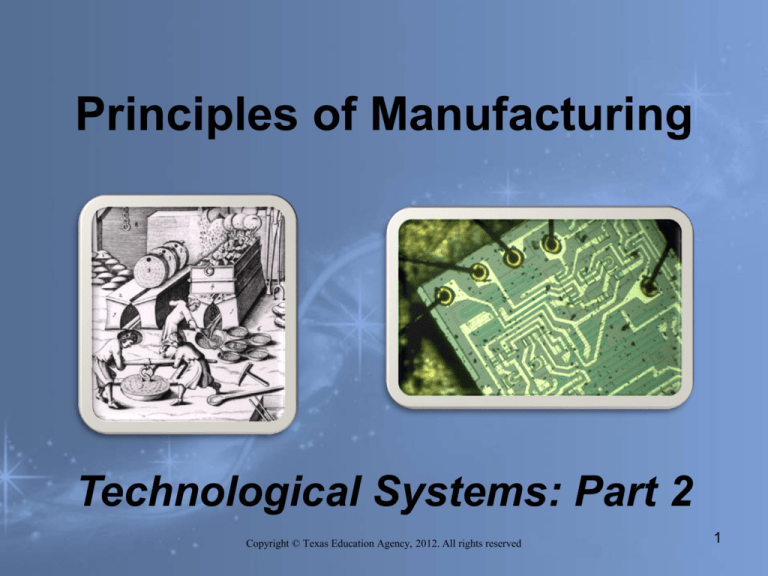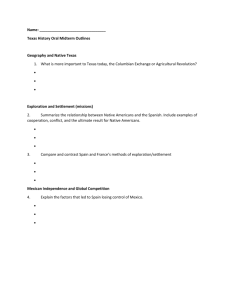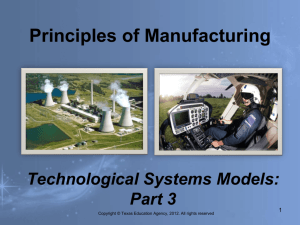
Principles of Manufacturing
.
Technological Systems: Part 2
Copyright © Texas Education Agency, 2012. All rights reserved
1
Bell Work Activity
Directions: Please take out a sheet of paper
and answer the following questions.
a. Make a list of what you feel are the top 5 inventions
in the past 50 years.
b. List 10 important uses of plastic.
c. Try and list 10 things people could have used in place of
plastic before it was invented.
Copyright © Texas Education Agency, 2012. All rights reserved
2
Warm-Up Activity
Engineering and Technology Terms
a. There are several important terms and
definitions students need to know.
b. Students will now complete the Matching
Definitions handout on Technological Systems.
Students may work in groups.
Copyright © Texas Education Agency, 2012. All rights reserved
3
Technological Systems:
The evolution of the manufacturing process:
A. Pre-Industrial Revolution
The Industrial Revolution occurred between the 18th and 19th
centuries. During this period significant technological
improvements were made in key industries like
manufacturing, agriculture, and mining.
Some of the key contributions of the era included:
Growth in technology
Standardized mass production of products
Growth of employment and income
opportunities
Copyright © Texas Education Agency, 2012. All rights reserved
4
Technological Systems:
The evolution of the manufacturing process:
A. Pre-Industrial Revolution (continued)
Prior to this period, associations of Guild Workers (master
craftsmen) were responsible for much of labor of the time.
Family units also performed work on a small scale. Key industries
were farming, cloth making, stone masons, metalworking and
woodworking.
5
Copyright © Texas Education Agency, 2012. All rights reserved
Technological Systems:
The evolution of the manufacturing process:
B. Post-Industrial Revolution
The invention of a variety of products and processes had a
tremendous impact on manufacturing in general .
Productivity in processes that had remained unchanged since
ancient times suddenly improved by 100% or more.
Scientists and inventors gained a better understanding of electricity,
explosives, steelmaking, chemistry, plastics, illnesses, medicines
and interchangeability parts in manufacturing.
Copyright © Texas Education Agency, 2012. All rights reserved
6
The effects of technological solutions
on the manufacturing process:
A. Intended
Manufacturing processes are created to meet the need of
demand.
Since the industrial revolution, advances in technology
have helped to increase the number products produced
and improved the quality worldwide. Computer
technology has become a necessary component in this
process.
Copyright © Texas Education Agency, 2012. All rights reserved
7
The effects of technological solutions
on the manufacturing process:
B. Unintended
The widespread destructiveness of World War I was
brought about because of advances in new technology.
Early on, the introduction of technological improvements
created huge demands for labor; however, this decimated
our agrarian-based economy.
The Economic impact of new technology is immeasurable.
In the United States, automation and outsourcing has
decimated what was once a labor-dependent
manufacturing base.
Copyright © Texas Education Agency, 2012. All rights reserved
8
Risks and benefits of engineering activities
on the manufacturing process:
Risks: Engineering activities in manufacturing evidently
will have positive and negative outcomes for society.
Waste disposal and a depletion of natural resources will
be a continuing issue.
Benefits: Engineering activities give us the capacity to
create products to meet the needs of a growing global
population and relieve human suffering. This ability will
continue to be highly valued.
Copyright © Texas Education Agency, 2012. All rights reserved
9
Examples of how engineering changes
environments:
A. Technology Life Cycle (TLC)
The creation of technology requires financial investment. Investors expect
a return on the funds expended to create new technologies.
The TLC focuses on the time and cost involved in developing technology.
Some products like steel and cement have long lifespans; other products
like medical products and electronics have a short lifespan.
This process affects the decision-making process involving technology
development.
Permission to use: GNU Free Documentation License
Copyright © Texas Education Agency, 2012. All rights reserved
10
Examples of how engineering changes
environments:
B. The impact of industrialization on the natural
environment
The ever-growing global human population will inevitably
place high demands on our engineering and
manufacturing processes. Managing the long term
impact of industrialization on our global environment will
be critical.
Our current processes will evolve to meet the need;
however it’s important for designers not to lose site of the
impact on the human element
11
Copyright © Texas Education Agency, 2012. All rights reserved







